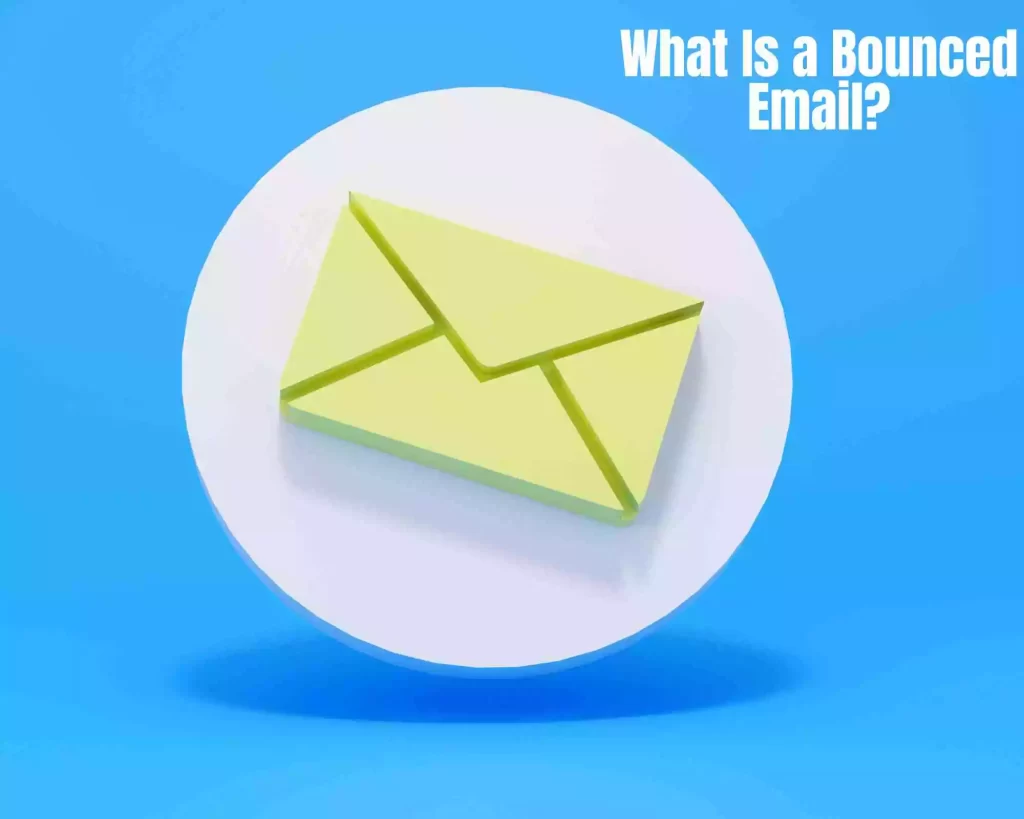What Is bounced email? It simply means a broken email, which means the receiver did not get your message. Common reasons for this to happen are permanent or temporary problems. When an email bounces, the recipient’s server will resend the notice to the sender’s email address.
31 billion emails bounce every day, according to Bounce.io. This indicates that 31 million communications are not delivered to their intended recipients. In other words, the work required to generate them all drains into the pool.
Email bounces are unavoidable in email marketing, but there’s surely a way to go about it. So what exactly is a bounced email? How do they function, and how can you repair them? Learn more in the article below.
Take advantage of this crucial information as a marketer because it will provide you with a wealth of information on the sender’s reputation and spam filter.
What Does It Mean If An Email Is Bounced?
Emails that Bounce are corrupted emails. Emails sent to these addresses won’t be delivered. If you make use of email marketing tools, they will usually be returned promptly. Bounced emails may be classified into two categories: soft and hard.
What is Soft Bounce
A soft email bounce happens when the recipient’s email address is temporarily lost. Shipment will be delayed but not fully stopped.
For soft bounce emails, some email marketing systems will continue to send them back to the addresses in case any flaws have been addressed. They can then send an email to you. If resend numerous times without success, the system will immediately erase such emails from the sending list.
If you’re sending manual emails and are receiving repeated soft bounces with the same addresses every time, you’re better off eliminating them from your email list.
What is hard Bounce?
If soft bounces are emails broken due to temporary errors, hard bounces are damaged due to long-term issues.
Emails with hard bounces need to be forgotten immediately since they are irreversible faults. Email marketing tools can assist you in achieving this. But, if you are sending letters by hand, take notice and erase these addresses.
It’s crucial to note that there are usually a few bounced emails in any email marketing campaign. This is extremely natural, and worrying too much about them is unnecessary.
Hard bounces vs. Soft Bounces
Though the implication of bounced emails is the same, both are not sent to the receiver. There are still different causes of failed delivery.
Hard bounce email error.
- Send messages to email addresses that don’t exist. Consumers often make a few errors while subscribing to the Email. They may have signed up for emails last used long ago, mistyped the email address, etc. Even with the mistake, the email address that does not exist is the most prevalent source of email bounce failures.
- The IP address you use is locked. While your material is extremely well invested, your IP address may still be restricted. This might happen because your address record needs to be fixed from sending or receiving too many spam emails. Email banned by the server (no forwarding): Emails might be stopped by the server for a number of reasons. Many servers may prohibit too big messages, emails that employ an inappropriate format, and material that will be considered spam. Mail servers might also block your Email if the form address may not match the account on the email server.
- The receiver blocks the Email. Many persons are able to filter receiving mail from unsolicited senders. These prohibited emails will become bounced emails.
Soft bounce email error
- Several email providers place restrictions on their email storage. When the user hits the limit number, the emails sent to this mailbox will all be converted to bounce emails. If clients erase old messages, they will be able to receive emails as usual.
- Even the greatest servers in the world are occasionally overburdened because the volume of mail transmitted is too big. Occasionally emails are bounced by overcrowded or non-existent servers. This mistake is akin to a soft bounce email condition.
- . When staff is on vacation or unavailable, they may set up an autoresponder to alert contacts about it. If the email address you’re attempting to reach has an auto-reply, you’ll get bounces, but messages may still be sent after turning off auto-reply.
What Causes A Bounced Email?
You presumably already know what bounce email is. So why is the Email bounced? How do they work? There are various variables that cause Email to fail. Here are a few frequent ones:
Email Bounce Due to Mailbox Full
One of the frequent causes of bounced emails is that the recipient’s inbox is full. Several email applications need more storage capacity. And this restriction covers papers and photographs.
If this limit is surpassed, the server will not allow any additional emails to be received. Additionally, it tells mailbox owners about the status. For example, the Gmail platform is restricted to 15GB per user account. When the memory is full, the user is informed about acting appropriately to clear up space. (Remove unneeded messages or files).
Email bounce due to message being too huge
Sometimes the content of the message or attachment needs to be bigger. That surpasses the limit of the receiving server. Big headers, text, and graphics make the message body shorter. Anything above 10MB is too much in most circumstances.
The Email bounced by a DNS problem.
In this circumstance, the Email cannot be sent to the destination owing to DNS difficulties of the receiving server. The name server’s setup for your domain might cause that. And you should contact your domain administrator for support.
Moreover, the fault may also reside in the SPF record. This bounced email cause might be transient or permanent.
Lastly, DNS issues may also originate from the mail server being down, a mistake when it was set up, or the target domain name being unavailable.
Email bounce due to the received mailbox being off-state and configured to auto-reply mode.
It’s vital to notice this email bounce is different from previous bounces. In this situation, your Email has been successfully sent to the recipient’s inbox. Then set up an automated response to alert the sender that they have received an email but are not online.
Nonetheless, these encounters should be closely monitored. If months have passed and the individual is still not online, consider deleting them from the list.
Email Bounce Due to being blacklisted
When a receiving email server stops incoming mail from the sender server owing to being blacklisted, it is generally known as Mail Blocking or Blacklisted. The following are the primary causes of this condition: • the sending address is listed on the Blacklist.
Inbound Email recognized as a spam source.
The recipient’s email server detects messages received from your account as a source of spam. This is assessed based on your email history or poor sending reputation.
The most prevalent reasons why emails bounce in this case:
Email bounce due to unable to access receiving server
If the bounced Email is in the “Undeliverable” category, the receiving email server is temporarily unavailable, overloaded, or undiscovered.
The server not found may have crashed or is under maintenance. Therefore you may only wait for the time to resend the Email. But, if the receiving address continues bouncing back many times, you should remove this contact.
Email bounce due to the receiver having banned the Email.
People may block Emails from senders they no longer wish to connect with. This signifies that a bounce will occur.
Email bounce due to attachment issue
If the attachment is faulty, the receiving email server may block your message:
In addition, the size of the attachment could create complications. Remember that your attachment size should not exceed 10MB.
For example, several email service providers have a maximum attachment size limit:
- 25MB limit for each Email received and sent.
- 10MB for each attachment.
- 25MB per Email and limitless for attachments through Drop Box.
Email Bounce Due To Received Email Address Is Misspelled
With this form of an email bounce, the recipient’s mail server cannot send your Email because the address is misspelled. The bounce message will inform the sender that the entered Email does not exist.
What Should I Do When Sending Bounced Email?
Stay calm if your Email gets bounced. You must filter out the infected emails and delete them so this issue does not reoccur. But, if the volume of broken emails on your list could be better, then you should assess the quality of your mailing list.
The quality of the list has a considerable influence on the outcomes of the email distribution and the efficacy of the overall campaign. If you send emails to a significant number of bounced emails, they will also damage the trustworthiness of the address you send them to. Here are a few techniques that might assist you in resolving email bounces:
How to Reduce Email Bounces
To pick the best method to reduce the number of bounces, you may look at the following advice:
Create a quality customer email list.
Verify email addresses before adding them to the mailing list to prevent damaged emails and bounces. Filter a normal email list with invalid emails.
A high bounce rate might impair the sender’s reputation. The quality of the list has a considerable influence on the outcomes of the email distribution and the efficacy of the overall campaign.
If you send messages to a significant number of bounced emails, they will also degrade the trustworthiness of the address you send them.
See also: How to create a quality customer email list.
Don’t purchase email lists.
Think you can create powerful email marketing campaigns by purchasing email lists? It saves you time gathering email lists, but you’re targeting individuals who:
Purchasing data will generate a huge email bounce rate and cause your sender address to lose trust.
Check out this article for why you shouldn’t purchase an email list.
Double-verify your content before sending.
Double-check your content before sending it out to determine if it violates server restrictions. With emails containing photographs, it is also crucial to decrease the image size so that they do not overflow your email capacity and not be sent.
Read more: How to prevent Email from getting to spam?
Employ the opt-in feature.
Send a confirmation email when a person subscribes to your list. This way, you can guarantee that the user’s Email is not just important but that they truly want to receive your Email.
Monitor your email delivery.
While doing bulk email marketing, monitoring the sending process by paying attention to the bounce rate is vital. If you check it often, you can discover possible issues before them happen or before inflicting a lot of harm.
Some email marketing software delivers complete email bounce reporting analytics, including bounce rate, causes for bounced emails, bounced email lists, etc., to assist marketers in measuring the quality of their email marketing campaigns. Consequently, timely adjustments.
Employ reliable email marketing software.
Utilizing reliable and quality email marketing software can assist in lowering the bounce rate of emails.
A reliable email marketing tool satisfies all the email marketing needs of marketers, from email design to content personalization, quality email address screening, effective measurement of campaigns, and reporting. Report faulty email rate, effective warning of email marketing efforts…
Outgoing email quality filter
An email filter tool to assist marketers in verifying outgoing email list emails, filtering out emails that don’t exist, interact badly, emails identified as spam, and unsubscribing to help marketers send emails to file lists data quality and prevent email bounce.
Deliver tailored emails to each customer.
To customize emails with material such as complete name, gender, nationality …, hence helps to enhance Inbox rates, build impressions and experience near to consumers. Consumers are, therefore, raising email open rates and improving conversion efficiency.
Track and assess the efficacy of Email Marketing campaigns
Email Marketing tool offers an excellent reporting system of email marketing campaigns with indications of successful delivery rate, email open rate, undelivered email rate, the link access rate in Email…
The reporting data is updated in multi-dimensional, allowing Marketers to properly assess the efficacy of email campaigns that are sent fast and instantaneously, from which to have ideal plans and exploit them. Effective extraction.
See also: the 18 email marketing campaigns you should track.
Solution to fix Email Bounce
Bounce is usually an indication of old sending techniques or poor email deliverability. To lower the bounce rate, you might refer to any of the following suggestions:
- Maintain good list hygiene. Periodically eliminate faulty email lists and inactive persons. A high bounce rate might impair the sender’s reputation. Hence, maintaining the list “clean” is the most reliable bridge to getting greater submission rates.
- Use double opt-in. Send a confirmation email when a person subscribes to the list. This helps confirm that the user’s Email is not only authentic but that they truly want to hear from you.
- Email sending tracking. Pay attention to the bounce rate as well as the response rate. Frequent monitoring lets you discover possible failures before they happen or before they do too much harm.
Getting high submission rates might be a difficulty. To achieve this, emphasize the following critical knowledge:
Conclusion
Email bounces are better than you think. It is an email returned to the sender because it cannot be sent to the recipient. Due to sending it to non-existent addresses, the receiver’s inbox is full, or the recipient is barred from receiving mail from you.
To avoid bounced emails, you should double-check email addresses, maintain your mailing list up-to-date, and test your emails before sending them out. When an email bounces, you may take actions to remedy the problem, such as confirming the recipient’s inbox and attempting to send the Email again. By following these procedures, you may minimize the quantity of bounced emails you get and enhance your email communication.
Hopefully, with this essay, you have acquired an understanding of broken email issues and know how to solve them. See also: Email bounces for what reasons?
Frequently Asked Questions about Email Bounce
What is the difference between a hard bounce and a soft bounce?
A soft bounce is a temporary delivery error, but a hard bounce occurs when an email is permanently undeliverable.
How can I know if my Email has bounced?
You will normally get a message that your Email was not sent, along with a reason for the Bounce.
How can I prevent my emails from bouncing?
You can prevent emails from bouncing by double-checking email addresses, keeping your mailing list up-to-date, eliminating spam trigger phrases, and testing your emails before sending them out.
What happens when an email bounces back?
When an email bounces back, it signifies that the Email was undeliverable and returned to the sender. The cause for the Bounce back might vary, but it typically signifies that the recipient’s email address is wrong or the inbox is full.
What is bounced vs. dropped Email?
Bounced emails are returned to the sender because they cannot be sent to the recipient. On the other hand, dropped emails are emails that are not delivered to the receiver but are not returned to the sender. Dropped emails might occur owing to several factors, such as spam filtering or technological faults.
Does Email bounce back if blocked?
Indeed, if an email address is blacklisted, emails sent to that address will bounce back to the sender. The Bounce back will normally contain a notice explaining that the Email was not delivered.
How long does Email bounce back?
Depending on the reason for the Bounce, the time it takes for an email to return may change. Soft bounces, and transitory delivery difficulties, may be rectified quickly, and the Email will finally be sent. Hard bounces, on the other hand, are permanent, and the Email will not be sent.
How do I fix a bounce back in Gmail?
To repair a bounce back in Gmail, double-check the email address and attempt sending the Email again. If the Email continues to bounce, you may need to delete the email address from your mailing list or contact the receiver to fix the problem.
Where do bounced emails go?
Bounced emails are usually returned to the sender with a message explaining why the Email was not delivered. Some email providers may also have a separate folder for bounced emails.
How do I check my email bounce?
You may check your email bounce by monitoring the number of emails you get or by utilizing an email tracking application that delivers bounce alerts.
What does a bounced email look like?
A bounced email will normally contain a note describing why the Email was not sent and may also include an error code or message.
Why are bounced emails bad?
Bounced emails may affect your email reputation and lead to your emails being labeled as spam or blacklisted by email providers. A large quantity of bounced emails could result in your account being suspended or canceled by your email service provider.
What is bounced vs. undeliverable Email?
Bounced emails are returned to the sender because they cannot be sent to the recipient. On the other hand, undeliverable emails are emails that are not delivered to the receiver for numerous reasons, including invalid email addresses or banned email accounts.
How many could email bounces be better?
A large number of email bounces might be a sign of difficulties with your mailing list or email content. As a general guideline, a bounce rate of more than 5% is considered excessive and may result in email delivery concerns.
Should I delete bounced emails?
Indeed, it is a good idea to delete bounced email addresses from your mailing list to enhance email deliverability and avoid complications with your email service provider.





